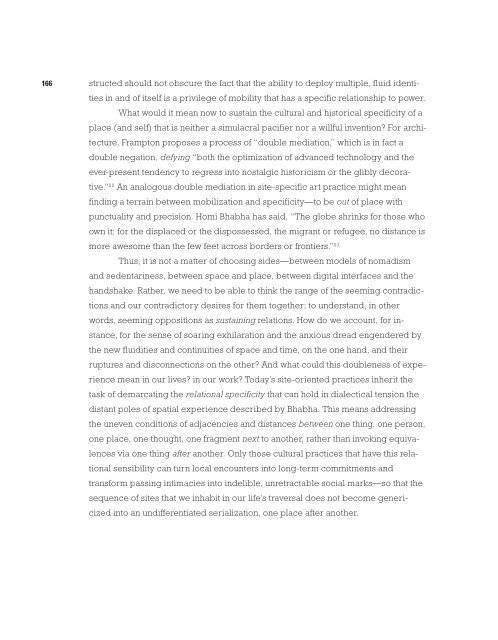ONE PLACE AFTER ANOTHER - Monoskop
ONE PLACE AFTER ANOTHER - Monoskop
ONE PLACE AFTER ANOTHER - Monoskop
You also want an ePaper? Increase the reach of your titles
YUMPU automatically turns print PDFs into web optimized ePapers that Google loves.
166 structed should not obscure the fact that the ability to deploy multiple, fluid identities<br />
in and of itself is a privilege of mobility that has a specific relationship to power.<br />
What would it mean now to sustain the cultural and historical specificity of a<br />
place (and self) that is neither a simulacral pacifier nor a willful invention? For architecture,<br />
Frampton proposes a process of “double mediation,” which is in fact a<br />
double negation, defying “both the optimization of advanced technology and the<br />
ever-present tendency to regress into nostalgic historicism or the glibly decorative.”<br />
22 An analogous double mediation in site-specific art practice might mean<br />
finding a terrain between mobilization and specificity—to be out of place with<br />
punctuality and precision. Homi Bhabha has said, “The globe shrinks for those who<br />
own it; for the displaced or the dispossessed, the migrant or refugee, no distance is<br />
more awesome than the few feet across borders or frontiers.” 23<br />
Thus, it is not a matter of choosing sides—between models of nomadism<br />
and sedentariness, between space and place, between digital interfaces and the<br />
handshake. Rather, we need to be able to think the range of the seeming contradictions<br />
and our contradictory desires for them together; to understand, in other<br />
words, seeming oppositions as sustaining relations. How do we account, for in-<br />
stance, for the sense of soaring exhilaration and the anxious dread engendered by<br />
the new fluidities and continuities of space and time, on the one hand, and their<br />
ruptures and disconnections on the other? And what could this doubleness of experience<br />
mean in our lives? in our work? Today’s site-oriented practices inherit the<br />
task of demarcating the relational specificity that can hold in dialectical tension the<br />
distant poles of spatial experience described by Bhabha. This means addressing<br />
the uneven conditions of adjacencies and distances between one thing, one person,<br />
one place, one thought, one fragment next to another, rather than invoking equiva-<br />
lences via one thing after another. Only those cultural practices that have this rela-<br />
tional sensibility can turn local encounters into long-term commitments and<br />
transform passing intimacies into indelible, unretractable social marks—so that the<br />
sequence of sites that we inhabit in our life’s traversal does not become genericized<br />
into an undifferentiated serialization, one place after another.

















